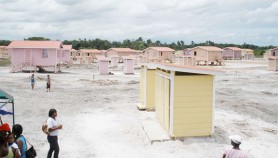The Little Red Village on the Essequibo Coast celebrated its first anniversary last month with a series of activities including a church service, concert and fun day.

This community is the first of its kind in the country and was built entirely by the non-governmental organization Food For the Poor (FFTP) in collaboration with the Roetheli family of the USA.
Prior to the establishment of the Little Red Village, the area, known as Sandpit was very bushy. There were just 15 houses there, which incidentally were built four years ago by FFTP, and it was fairly isolated.
However, FFTP had noted the need for housing in the area where many families lived in shacks. After meetings with the people of the area, an initiative was taken to clear the land following which it was decided that each house lot would be an approximate size of 50 ft by 100 ft. Villagers were then mandated to purchase the land from government and because of their circumstances, FFTP negotiated with the government for a minimum price, which was settled on at $66,000 per house lot.
The Roetheli family along with Food For The Poor then constructed 100 houses, each of which is solar-powered. Residents paid a nominal fee of $3,000 each for their solar power. Pipe lines have been run in each yard to provide water but unfortunately those pipes are not utilitarian as yet. That is so because the correct pump size has not yet been found.
Villagers get water from a well, which is located in the village, but it is a long and tiresome walk from their home to the water source. But villagers said they will endure until the pump is installed. Each household is required to pay the sum of $500 every month in order to power the generator of the well, which was also provided by FFTP.
The organization has also constructed a school in the community. Judy’s School of New Beginnings is an annex of the Suddie Primary School, located miles from the village. The school was opened on March 8 this year and at present it is accommodating 20 students from the village who cannot afford to travel any distance to school. However, from the new school year, which begins in September there will be 76 Little Red Villagers between the ages of six and 13 years old attending the school. The community now also has a Little Red Store and a Community Life Centre, which houses the library and will host a computer class which is about to commence soon. Villagers pay a flat fee of $300 at the Little Red Store and receive foodstuff, clothing and other household utilities from Food for the Poor on a weekly basis.
So far, the Little Red Village project has cost FFTP and the Roetheli family $144 million. FFTP has indicated that its future plans for the Little Red Village include building another school, a shopping mall, a bakery outlet and opening a sewing project. “People will have an opportunity to empower themselves,“ Camille Liladri, Senior Public Relations Officer of FFTP said.
FFTP still continues to provide household items like tables and chairs to the residents.
Meanwhile, some residents have begun to improve their own lives and have purchased water tanks and fenced their yards. Villagers also co-operate willingly in community works.
March 11 marked one year since the establishment of that community and on March 20 and 21 activities were held to celebrate the first anniversary. There was a church service on March 20 attended by the villagers as well as Liadri, FFTP Head Leon Davis, Project Manager Iva Peters and Cromwell Mentis.
Davis, in his remarks, promised the Little Red Villagers an “improved lifestyle”. He also highlighted plans to further develop the community.
Community members gave testimonials of how their lives were before and how with the help of FFTP they have improved. “We never know we could’ve gained this much,“ one of the villagers said.
Appreciation was also expressed through dances, acrostics, poems and songs.
The fun day on March 21 included a food sale, games and music. Persons from outside the village were present at that celebration.
The Little Red Village has an exquisite beauty. The area is not fertile enough to cultivate crops which do not grow in sandy areas. But members of the community who are working very hard in unity to develop their community say it is a safe and tranquil area to live.








